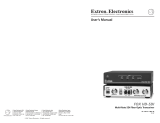Page is loading ...

This guide provides instructions for an experienced installer to set up and operate
Extron
®
FOX 3G HD-SDI Transceiver.
The transceiver can be configured via its rear panel Mode DIP switches to operate in one
of three ways:
• Bidirectional transceiver
• Transmitter
• Receiver
See Transceiver Configurations on the rear of this guide if you need more information.
NOTE: In this guide, the term “transceiver” refers to any FOX 3G HD-SDI; the term “bidirectional transceiver” refers to a
FOX 3G HD-SDI specifically configured as a bidirectional transceiver.
Installation
Step 1 — Mounting
Turn off or disconnect all equipment power sources and mount the transceiver as required.
Step 2 — Connections and Initial Settings
a
HD-SDI Input connector — If the FOX 3G HD-SDI is configured as
either a bidirectional transceiver or as a transmitter, connect an
HD-SDI, SDI, or 3G-SDI video input to this BNC connector.
b
Mode switches — Set these DIP switches to the
positions shown at right to select the transceiver
configuration. See Transceiver Configurations on the
rear of this guide for more information.
c
Fiber optic connectors —
WARNING: This unit outputs continuous invisible light, which may be harmful to the eyes; use with caution. For
additional safety, plug the attached dust caps into the optical transceivers when the fiber optic cable is
unplugged.
NOTE: Ensure that you use the proper fiber cable for your transceivers. Typically, singlemode fiber cable has a
yellow jacket and multimode fiber cable has an orange or aqua jacket.
Tx connector — In any configuration, connect a fiber optic cable to the Optical Tx LC connector.
Connect the free end of this fiber optic cable to the Optical Rx connector on another FOX 3G HD-SDI transceiver that is
configured as a bidirectional transceiver or as a receiver.
Rx connector — In either the bidirectional transceiver or receiver configuration, connect a fiber optic cable to the
Optical Rx connector to receive the signal from the transmitting unit. Connect the free end as detailed below:
• In a 2-transceiver system, connect the free end of this cable to the Optical Tx connector on the transmitting unit,
which is configured as a transmitter.
• In a daisy-chained system, connect the free end of this cable to the Optical Tx connector on the previous unit in the
daisy chain (configured as either a bidirectional transceiver or a transmitter).
d
Buffered Outputs connectors — In any FOX 3G HD-SDI configuration, connect a digital display to these BNC connectors.
In the bidirectional transceiver configuration, connectors 1 and 2 both output the video that is sent from the other
transceiver.
In the receiver configuration, only connector 2 outputs video and it is the
video sent by the transmitting unit.
In the transmitter configuration, connectors 1 and 2 both output the video
signal that is input on the HD/SDI Input connector,
a
, on the same transceiver.
e
Power connector — Plug the included external 12 VDC power supply into this
2-pole captive screw connector as shown at right. Use the supplied tie-wrap to
strap the power cord to the extended tail of the connector.
12V
0.3A MAX
FOX HDSDI
HD/SDI IN
POWER
BUFFERED OUTPUTS
MODE
OPTICAL
RxTx
1 2
1 2
25 1
3 4
SW2 Mode
Down
Down
Up
Up
Down
Up
Down
Up
Bidirectional transceiver (default position)
Transmitter with local monitor outputs
Receiver with daisy chaining
Spare (functions as receiver with daisy chaining)
SW1
MODE
1 2
Power Supply
Output Cord
SECTION
A–A
Ridges
Smooth
A A
Tie Wrap
3
5
1
FOX 3G HD-SDI Setup Guide

Operation
After the transmitting and receiving units and all of their connected devices are powered up, the system is fully operational.
If any problems are encountered, ensure all traditional and fiber cables are routed and connected properly. If your problems
persist, call the Extron S
3
Sales & Technical Support Hotline that is closest to you, at the number shown below.
Fiber Compatibility Indications
Use the proper fiber cable for your transceivers. Each transceiver indicates its fiber compatibility,
singlemode or multimode, at power-up by blinking the four front panel Rate indicators, once for
multimode or twice for singlemode.
NOTE: All transceivers in the system must be the same model (either all singlemode or all multimode). Mixed transmission mode
units will not work together.
Transceiver Configurations
Bidirectional Transceiver
A bidirectional transceiver inputs digital video on its SDI/HD-SDI Input BNC. The transceiver converts the video input to a
proprietary signal and transmits it over a fiber link to another FOX 3G HD-SDI that is configured as either a bidirectional
transceiver or as a receiver.
A bidirectional transceiver can
also simultaneously receive a
proprietary signal from
another transceiver (in
any configuration) on its
Optical Rx port, convert the
proprietary signal
back to the original format
digital video, and output
the video on its own two
Buffered Outputs BNC
connectors.
Transmitter and Receiver
A unit configured as a transmitter inputs digital video on its HD/SDI Input BNC. The transmitter converts the video input
to a proprietary signal and transmits the video over a fiber link to a FOX 3G HD-SDI that is configured as a receiver or as a
bidirectional transceiver. The transmitter also simultaneously outputs the digital video on its two Buffered Outputs BNCs.
A unit configured as a receiver
accepts a proprietary signal on
its Rx fiber optic port.
The receiver converts the
proprietary signal back to
original HD-SDI, SDI, or
3G-SDI video and outputs
the video on only one of its
own Buffered Output BNC
connectors, Output 2.
The receiver converts the
second digital video signal
that it created from the
optical input back into a proprietary signal and outputs it on the Optical Tx port over a fiber link to another FOX 3G HD-SDI
that is configured as a receiver or as a bidirectional transceiver.
NOTE: Up to 10 receivers can be daisy-chained in this manner.
68-1384-50
Rev A
07 10
Extron USA - West
Headquarters
+800.633.9876
Inside USA/Canada Only
+1.714.491.1500
+1.714.491.1517 FAX
Extron USA - East
+800.633.9876
Inside USA/Canada Only
+1.919.863.1794
+1.919.863.1797 FAX
Extron Europe
+800.3987.6673
Inside Europe Only
+31.33.453.4040
+31.33.453.4050 FAX
Extron Asia
+800.7339.8766
Inside Asia Only
+65.6383.4400
+65.6383.4664 FAX
Extron Japan
+81.3.3511.7655
+81.3.3511.7656 FAX
Extron China
+400.883.1568
Inside China Only
+86.21.3760.1568
+86.21.3760.1566 FAX
Extron Middle East
+971.4.2991800
+971.4.2991880 FAX
© 2010 Extron Electronics. All Rights Reserved. www.extron.com
12V
0.3A MAX
FOX HDSDI
HD/SDI IN
POWER
BUFFERED OUTPUTS
MODE
OPTICAL
RxTx
1 2
12V
0.3A MAX
FOX HDSDI
HD/SDI IN
POWER
BUFFERED OUTPUTS
MODE
OPTICAL
RxTx
1 2
HD-SDI
In From
Source A
FOX 3G HD-SDI configured as bidirectional transceiver FOX 3G HD-SDI configured as bidirectional transceiver
HD-SDI
Out From
Source B
HD-SDI
Out From
Source B
HD-SDI
In From
Source B
HD-SDI
Out From
Source A
HD-SDI
Out From
Source A
12V
0.3A MAX
FOX HDSDI
HD/SDI IN
POWER
BUFFERED OUTPUTS
MODE
OPTICAL
RxTx
1 2
12V
0.3A MAX
FOX HDSDI
HD/SDI IN
POWER
BUFFERED OUTPUTS
MODE
OPTICAL
RxTx
1 2
FOX 3G HD-SDI configured as transmitter FOX 3G HD-SDI configured as receiver
FOX HD-SDI(s)
Configured as receiver(s)
Transmitted HD-SDI
from source A
HD-SDI
In From
Source A
HD-SDI
Out From
Source A
HD-SDI
Out From
Source A
HD-SDI
Out From
Source A
UNKNOWN
2.97
Gbps
1.485
Gbps
RATE
270
Mbps
2
FOX 3G HD-SDI Setup Guide (Continued)
/





